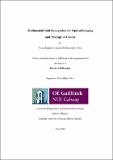Multimodal gold nanoprobes for optical imaging and therapy of cancer

View/
Date
2016-05-20Author
Ayanam Parthasarathy, Vijaya Raghavan
Metadata
Show full item recordUsage
This item's downloads: 1075 (view details)
Abstract
In the recent past, there has been an accelerated development in medical modalities for the early diagnosis and treatment of cancer. Tissue conservation of neighbouring healthy tissue and development of a minimally/non-invasive treatment for cancer remain the primary unsolved issues regarding cancer treatments/therapies. Nanoparticle contrast agents for molecular targeted imaging have widespread interest in diagnostic applications with cellular resolution, specificity and selectivity for visualization and assessment of various disease processes. Of particular interest is the gold nanoparticle, owing to its tunability of the surface plasmon resonance (SPR) and its relative inertness. This study explores adjusting various wet chemical synthesis parameters to synthesise anisotropic gold nanoparticles with surface plasmon resonance (SPR) in the near infra-red (NIR) region of the electromagnetic spectrum. Multimodal nanoprobes were then constructed with these anisotropic gold nanoparticles as core to be used with multiple optical imaging and therapeutic modalities.
To achieve this goal, multibranched gold nanoparticles (nanostars) were synthesised using a one-pot synthesis methodology. The SPR wavelength of the nanostars was tuned to be within the optical imaging window of 600 – 900 nm by varying synthesis parameters such as pH, temperature and ratio of reducing agent to the gold precursor. For the construction of multimodal gold nanoprobes, gold nanostars were first coated with a monolayer of diethylthiatricarbocyanine iodide (DTTCi), a Raman reporter dye. In a separate reaction, bovine serum albumin (BSA) was chemically denatured to expose the thiol groups, which was conjugated with photosensitisers (PS), hypericin and chlorin e6, to protect the fluorescence of photosensitisers from quenching by the gold nanostars. This BSA-PS conjugate was added to the nanostars to complete the synthesis of the multimodal nanoprobe. This nanoprobe was optically characterised using UV-Visible, fluorescence and Raman spectroscopy to confirm the retention of optical properties of all the individual components. The therapeutic ability of the nanoprobe was examined by investigating the singlet oxygen generation and photothermal capability by purpose-built laser setup and UV-Vis spectroscopy.
The structure and shape of the gold nanostars were further optimised for the SPR to lie within the second optical window (1050 – 1400 nm) to further enhance the contrast for deep tissue imaging. Synthesis methodology included using silver ions for gold to be reduced on its surface, thereby growing into nanostars with longer and sharper branches, which reflected in the SPR band red shifting to 1050-1200 nm. Finite difference time domain (FDTD) simulations demonstrated the tunability of the SPR and surface charge distribution of these nanostars. Silica coated gold nanostars were successfully used as contrast agent for Photoacoustic Imaging (PAI) of nanostars embedded phantoms. NIR in vivo PAI and photothermal efficiency of gold nanostars were then investigated as a proof-of-concept. Xenografted tumours were administered with nanostars and irradiated using 1064 nm continuous wave laser (0.5 W/cm2 for 10 minutes) and the localised temperature increase (photothermal effect) was monitored using thermal imaging. PAI was used to image the localisation and retention of nanostars within tumours, and was also used to measure the tumour volume. The ≈9℃ temperature increase within tumours induced localised hyperthermia which shrunk the tumour volume initially and the subsequent increase in tumour size did not reach significance. This tumour regrowth after photothermal therapy (PTT) was suggestive of thermo-resistance by cancer cells as a result of mild hyperthermia. The quantification of tumour destruction at cellular level showed 39.8% decrease in the percent cellular area of the tumours that underwent PTT demonstrated that the PT effect of nanostars did result in significant tumour cell death.

